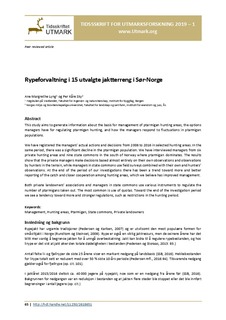Rypeforvaltning i 15 utvalgte jaktterreng i Sør-Norge
Journal article

Åpne
Permanent lenke
http://hdl.handle.net/11250/2618651Utgivelsesdato
2019Metadata
Vis full innførselSamlinger
- Tidsskriftet Utmark [67]
Sammendrag
This study aims to generate information about the basis for management of ptarmigan hunting areas, the options managers have for regulating ptarmigan hunting, and how the managers respond to fluctuations in ptarmigan populations.
We have registered the managers’ actual actions and decisions from 2006 to 2016 in selected hunting areas. In the same period, there was a significant decline in the ptarmigan population. We have interviewed managers from six private hunting areas and nine state commons in the south of Norway where ptarmigan dominates. The results show that the private managers make decisions based almost entirely on their own observations and observations by hunters in the terrain, while managers in state commons use field surveys combined with their own and hunters’ observations. At the end of the period of our investigations there has been a trend toward more and better reporting of the catch and closer cooperation among hunting areas, which we believe has improved management.
Both private landowners’ associations and managers in state commons use various instruments to regulate the number of ptarmigans taken out. The most common is use of quotas. Toward the end of the investigation period we see a tendency toward more and stronger regulations, such as restrictions in the hunting period.